
Concept explainers
(a)
Interpretation:
Whether the given monosaccharide is a D or L sugar needs to be determined.
Concept Introduction:
The configuration stereochemistry of the molecule is represented as D and L enantiomers. In the L isomer of a carbohydrate, the
All the natural sugars are D-isomers.
Answer to Problem 67P
D-isomer
Explanation of Solution
The given monosaccharide is as follows:
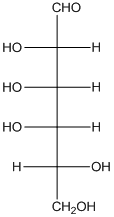
From the structure, the hydroxyl group to the carbon atom away from carbonyl group that is C-5 as hydroxyl group on right hand side thus, it is a D-isomer.
(b)
Interpretation:
The type of carbonyl and number of atoms in the chain of the given monosaccharide needs to be determined.
Concept Introduction:
Monosaccharides are simplest sugar and basic units of carbohydrates. The monosaccharides are further hydrolyzed to form simpler chemical compounds. The general fromula of carbohydrate is
Answer to Problem 67P
Aldehyde group with 6 carbon atom: aldohexose.
Explanation of Solution
The given monosaccharide is as follows:
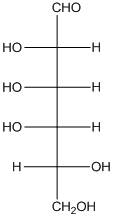
There are 6 carbon atoms present in it and there is an aldehyde group thus, it is an aldohexose.
Thus, the type of carbonyl group is aldehyde and number of atoms in chain is 6 carbon atoms.
(c)
Interpretation:
The enantiomers of the given monosaccharide need to be determined.
Concept Introduction:
The configuration stereochemistry of the molecule is represented as D and L enantiomers. In the L isomer of a carbohydrate, the
Answer to Problem 67P
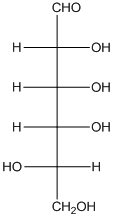
Explanation of Solution
The given monosaccharide is as follows:
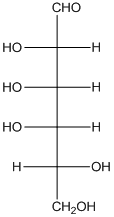
From the structure, the hydroxyl group to the carbon atom away from carbonyl group that is C-5 as hydroxyl group on right hand side thus, it is a D-isomer.
The enantiomer of the given monosaccharide will be L-isomer. The enantiomer of the D-isomer will be non-superimposable mirror image of it. Thus, the structure of L-isomer will be as follows:
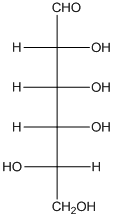
(d)
Interpretation:
The chirality centers needs to be labelled.
Concept Introduction:
The molecules in which there is one or more chiral centers are known as chiral molecules. A carbon attached to four different groups or atom is chiral in nature. The chiral molecules which are mirror images of each other are known as enantiomers. The chiral molecules are non-superimposable to each other. Non-superimposible means one molecule cannot be placed on the other molecule.
Answer to Problem 67P
The 4 chiral centers are represented as follows:
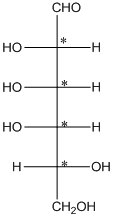
Explanation of Solution
The given monosaccharide is as follows:
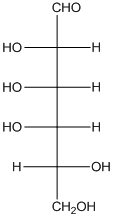
The chiral carbon atom has 4 different groups attached to it. Thus, the labelled carbon atoms are chiral in nature.
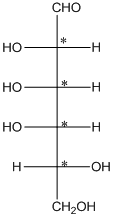
Thus, there are 4 chiral centers in the molecules.
(e)
Interpretation:
The
Concept Introduction:
An epimer is a stereoisomer having difference in configuration at any one chiral center. In the case of anomer, the difference in configuration takes place at the hemiacetal carbon in the cyclic form. The carbon atom is known as anomeric carbon.
Both the
Answer to Problem 67P
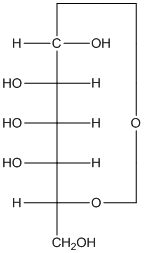
Explanation of Solution
The given monosacchride is as follows:
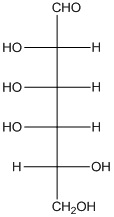
The
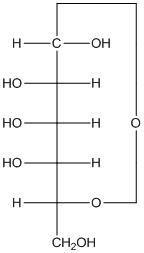
(f)
Interpretation:
The product from the reaction of monosaccharide with Benedict's reagent needs to be determined.
Concept introduction:
Benedict's reagent is used as a mild oxidizing agent and can oxidize aldehyde into the corresponding acid.
Answer to Problem 67P
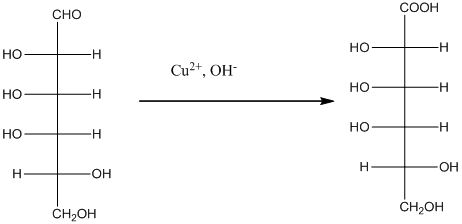
Explanation of Solution
The given monosacchride is as follows:
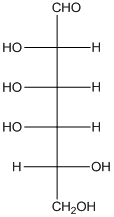
The Benedict's reagent is used as a mild oxidizing agent. Here, Cu2+ complexed with citrate and OH- are present in the Benedict's reagent which is used to identify reducing sugars. It is used as a mild oxidizing agent and can oxidize aldehyde into the corresponding acid. A hydroxyl group is added to the carbon with the carbonyl group when this reagent is added. Cu2+ is converted to Cu+ which then precipitates as Cu2O which is a brick red precipitate.
The reaction is represented as follows:
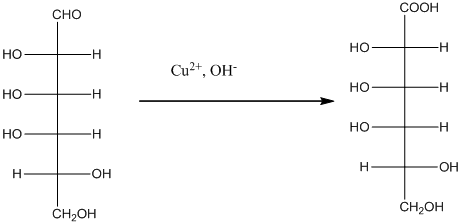
(g)
Interpretation:
The product formed on reaction of monosaccharide with
Concept introduction:
H2, Pd is used as a reducing agent to reduce compounds like
Answer to Problem 67P
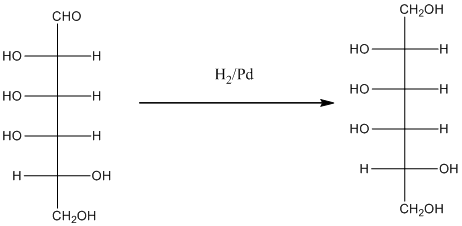
Explanation of Solution
When H2, Pd is added to aldehyde (reducing sugars), the corresponding alcohol is formed. The double bonded oxygen of the aldehyde turns to a hydroxyl group and one hydrogen atom is added to the carbon containing the respective oxygen atom. Pd is the catalyst of this reaction. H2 breaks and gets added as H atoms to oxygen atom and the carbon atom.
The given monosacchride is as follows:
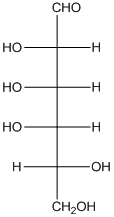
Thus, the reaction with H2, Pd is represented as follows:
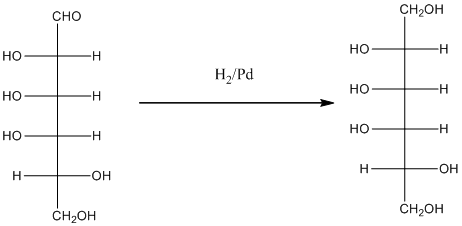
(h)
Interpretation:
The monosaccharide needs to be labelled as a reducing or non-reducing sugar.
Concept Introduction:
A reducing sugar is defined as any sugar capable of behaving as a reducing agent having a free aldehyde group or a free ketone group. All monosaccharide are reducing sugars. There are some disaccharides, oligosaccharides and polysaccharides which are also reducing sugars.
Answer to Problem 67P
The given monosaccharide is a reducing sugar.
Explanation of Solution
The given monosaccharide is represented as follows:
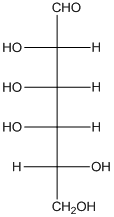
Since, all the monosaccharides are reducing sugar thus, it is also reducing sugar. A reducing sugar acts as a reducing agent. Thus, on reaction with
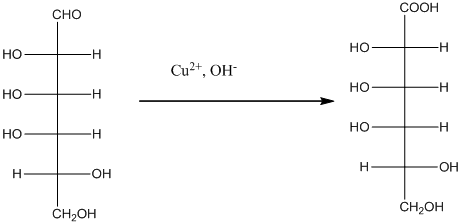
Want to see more full solutions like this?
Chapter 20 Solutions
General, Organic, and Biological Chemistry - 4th edition
- dict the major products of this organic reaction. C Explanation Check 90 + 1.0₂ 3 2. (CH3)2S Click and drag f drawing a stru © 2025 McGraw Hill LLC. All Rights Reserved. • 22 4 5 7 8 Y W E R S F H Bilarrow_forwardcan someone draw out the reaction mechanism for this reaction showing all the curly arrows and 2. Draw the GPNA molecule and identify the phenylalanine portion. 3. Draw L-phenylalanine with the correct stereochemistryarrow_forwardWhat is the reaction mechanism for this?arrow_forward
- Predict the major products of both organic reactions. Be sure to use wedge and dash bonds to show the stereochemistry of the products when it's important, for example to distinguish between two different major products. esc esc Explanation Check 2 : + + X H₁₂O + Х ง WW E R Y qab Ccaps lock shift $ P X Click and drag to start drawing a structure. © 2025 McGraw Hill LLC. All Rights Reserved. Terms of Use | Privacy Center | Accessibility Bil T FR F18 9 G t K L Z X V B N M control opption command command T C darrow_forwardDraw the Markovnikov product of the hydrohalogenation of this alkene. this problem. Note for advanced students: draw only one product, and don't worry about showing any stereochemistry. Drawing dash and wedge bonds has been disabled for caps lock Explanation Check 2 W E R + X 5 HCI Click and drag to start drawing a structure. © 2025 McGraw Hill LLC. All Rights Reserved. Terms of Use | Privacy Center | Accessibility Bil Y F G H K L ZZ X C V B N M control opption command F10 F10 command 4 BA Ar Carrow_forwardI don't understand why the amide on the top left, with the R attached to one side, doesn't get substituted with OH to form a carboxylic acid. And if only one can be substituted, why did it choose the amide it chose rather than the other amide?arrow_forward
- esc Draw the Markovnikov product of the hydration of this alkene. Note for advanced students: draw only one product, and don't worry about showing any stereochemistry. Drawing dash and wedge bonds has been disabled for this problem. Explanation Check BBB + X 0 1. Hg (OAc)2, H₂O 2. Na BH 5 Click and drag to start drawing a structure. © 2025 McGraw Hill LLC. All Rights Reserved. Terms of Use | Privacy Center | Accessibility Bl P 豆 28 2 28 N 9 W E R T Y A S aps lock G H K L Z X C V B N M T central H command #e commandarrow_forwardC A student proposes the transformation below in one step of an organic synthesis. There may be one or more products missing from the right-hand side, but there are no reagents missing from the left-hand side. There may also be catalysts, small inorganic reagents, and other important reaction conditions missing from the arrow. • Is the student's transformation possible? If not, check the box under the drawing area. . If the student's transformation is possible, then complete the reaction by adding any missing products to the right-hand side, and adding required catalysts, inorganic reagents, or other important reaction conditions above and below the arrow. • You do not need to balance the reaction, but be sure every important organic reactant or product is shown. (X) This transformation can't be done in one step. + Tarrow_forwardく Predict the major products of this organic reaction. If there aren't any products, because nothing will happen, check the box under the drawing area instead. No reaction. Explanation Check OH + + ✓ 2 H₂SO 4 O xs H₂O 2 Click and drag to start drawing a structure. © 2025 McGraw Hill LLC. All Rights Reserved. Terms of Use | Privacy Centerarrow_forward
- Draw the skeletal ("line") structure of 1,3-dihydroxy-2-pentanone. Click and drag to start drawing a structure. X Parrow_forwardPredicting edict the major products of this organic reaction. If there aren't any products, because nothing will happen, check the box under the drawing area instead. + No reaction. Explanation Check HO Na O H xs H₂O 2 Click and drag to start drawing a structure. © 2025 McGraw Hill LLC. All Rights Reserved. Terms of Use | Privacy Center Iarrow_forwardChoosing reagents and conditions for acetal formation or hydrolysis 0/5 A student proposes the transformation below in one step of an organic synthesis. There may be one or more products missing from the right-hand side, but there are no reagents missing from the left-hand side. There may also be catalysts, small inorganic reagents, and other important reaction conditions missing from the arrow. • Is the student's transformation possible? If not, check the box under the drawing area. If the student's transformation is possible, then complete the reaction by adding any missing products to the right-hand side, and adding required catalysts, inorganic reagents, or other important reaction conditions above and below the arrow. • You do not need to balance the reaction, but be sure every important organic reactant or product is shown. + This transformation can't be done in one step. 5 I H Autumn alo 值 Ar Barrow_forward
 Chemistry for Today: General, Organic, and Bioche...ChemistryISBN:9781305960060Author:Spencer L. Seager, Michael R. Slabaugh, Maren S. HansenPublisher:Cengage Learning
Chemistry for Today: General, Organic, and Bioche...ChemistryISBN:9781305960060Author:Spencer L. Seager, Michael R. Slabaugh, Maren S. HansenPublisher:Cengage Learning World of Chemistry, 3rd editionChemistryISBN:9781133109655Author:Steven S. Zumdahl, Susan L. Zumdahl, Donald J. DeCostePublisher:Brooks / Cole / Cengage Learning
World of Chemistry, 3rd editionChemistryISBN:9781133109655Author:Steven S. Zumdahl, Susan L. Zumdahl, Donald J. DeCostePublisher:Brooks / Cole / Cengage Learning Introductory Chemistry: An Active Learning Approa...ChemistryISBN:9781305079250Author:Mark S. Cracolice, Ed PetersPublisher:Cengage Learning
Introductory Chemistry: An Active Learning Approa...ChemistryISBN:9781305079250Author:Mark S. Cracolice, Ed PetersPublisher:Cengage Learning Introductory Chemistry: A FoundationChemistryISBN:9781337399425Author:Steven S. Zumdahl, Donald J. DeCostePublisher:Cengage LearningChemistry: Matter and ChangeChemistryISBN:9780078746376Author:Dinah Zike, Laurel Dingrando, Nicholas Hainen, Cheryl WistromPublisher:Glencoe/McGraw-Hill School Pub Co
Introductory Chemistry: A FoundationChemistryISBN:9781337399425Author:Steven S. Zumdahl, Donald J. DeCostePublisher:Cengage LearningChemistry: Matter and ChangeChemistryISBN:9780078746376Author:Dinah Zike, Laurel Dingrando, Nicholas Hainen, Cheryl WistromPublisher:Glencoe/McGraw-Hill School Pub Co Organic ChemistryChemistryISBN:9781305580350Author:William H. Brown, Brent L. Iverson, Eric Anslyn, Christopher S. FootePublisher:Cengage Learning
Organic ChemistryChemistryISBN:9781305580350Author:William H. Brown, Brent L. Iverson, Eric Anslyn, Christopher S. FootePublisher:Cengage Learning





